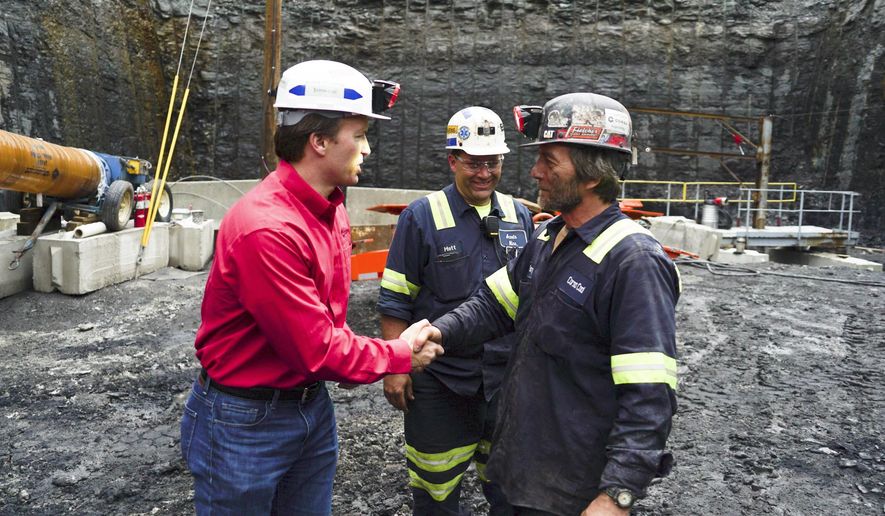Just five months into President Trump’s tenure, signs show that the U.S. coal sector has begun a slight rebound from the historic lows reached during the Obama era — but even the most ardent coal proponents say the revival will be short-lived.
The number of American coal miners has steadily increased since Mr. Trump was elected in November and hit 51,000 last month, the highest level in over a year. In the first five months of the year, total coal production was up 17 percent compared with the same period last year, according to federal figures. Coal production during the final week of May was 22 percent higher than during the same week last year, with nearly 15 million short tons, Energy Information Administration data show.
Trump administration officials have touted the numbers as proof that Mr. Trump is fulfilling a campaign promise that struck an emotional chord with voters in the key Rust Belt states that propelled him to victory. The White House repeatedly has declared that the “war on coal” of the Obama years has officially ended.
But the early uptick, while encouraging, doesn’t mean the coal industry will regain all of the jobs lost in recent years, and the increases can be at least partially explained by normal seasonal changes in employment and production. Energy market analysts, sector leaders and even vehemently pro-coal lawmakers on Capitol Hill are tempering their own expectations while the administration boasts that it is breathing new life into American coal.
“We hope to see sustained job increases but don’t see the elements in place for long-term employment gains yet,” said Phil Smith, a spokesman for the United Mine Workers of America.
Energy market analysts say the long-term forecast for coal is bleak. Although Obama-era regulations clearly had some effect, they say, the biggest impact on the coal sector has been the rise of cheap, abundant natural gas.
The administration will continue to promote coal mining, but officials are slashing regulations on oil and gas exploration, specifically to open more federal land for drilling. Absent a major shake-up in the gas market — such as a massive, unexpected price hike — it’s difficult to imagine the coal sector regaining its past glory, especially with many coal-fired power plants and utilities moving toward cheaper natural gas.
“You can’t have natural gas prices below $2 and not have the coal industry be impacted,” said Dan Klein, managing director of global coal at PIRA Energy, an analytics unit of S&P Global Platts.
“Having a bit of recovery is possible, but it’s not exactly getting anywhere close to the heyday of demand and production,” he said. “There are factors stacked up against coal usage in the country, and one of them is just the age of coal-fired power plants across the country.”
Administration officials, however, are painting a much more optimistic picture. Environmental Protection Agency Administrator Scott Pruitt argued last week that Mr. Trump’s policies have quickly had a massive impact on jobs in the coal sector.
“We’ve had over 50,000 jobs since last quarter — coal jobs, mining jobs — created in this country. We had almost 7,000 mining and coal jobs created in the month of May alone,” he told ABC’s “This Week” on June 4. “The unemployment rate is 4.3 percent, as you know, George. This president’s deregulation agenda, particularly in the energy space, is making a substantial impact on the jobs across this country and giving people hope.”
Mr. Pruitt’s statistics, while technically true, are misleading. The 50,000 number includes the entire mining and logging sector and includes support jobs for the coal sector. The Bureau of Labor Statistics subcategory counts a host of positions not directly related to coal mining.
Furthermore, the number of coal miners — about 51,000 as of the end of May — began to rise during the final months of President Obama’s tenure. Coal mining jobs bottomed out in September at 49,600 and then began a slow climb.
The production side is perhaps more encouraging for coal champions. While production typically rises through the spring and summer, the total amount of mined coal so far this year is about 314 million short tons, compared with 274 million short tons during the same time period last year.
Pro-coal lawmakers said they are grateful for the administration’s efforts to revitalize the industry.
“The new administration has been a breath of fresh air for coal miners who endured a withering assault over the last eight years. They now have some reason for hope, and the uptick in production, jobs and investment is reflective of that,” said Rep. David B. McKinley, West Virginia Republican and chairman of the Congressional Coal Caucus.
But he, too, put a damper on expectations.
“None of us are under the illusion coal will regain the position it held 20 or 30 years ago,” he said. “But it can continue to play a significant role in providing reliable, low-cost energy.”
• Ben Wolfgang can be reached at bwolfgang@washingtontimes.com.




Please read our comment policy before commenting.